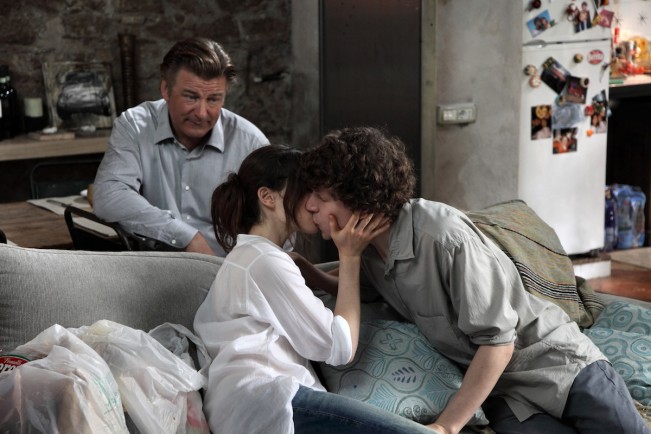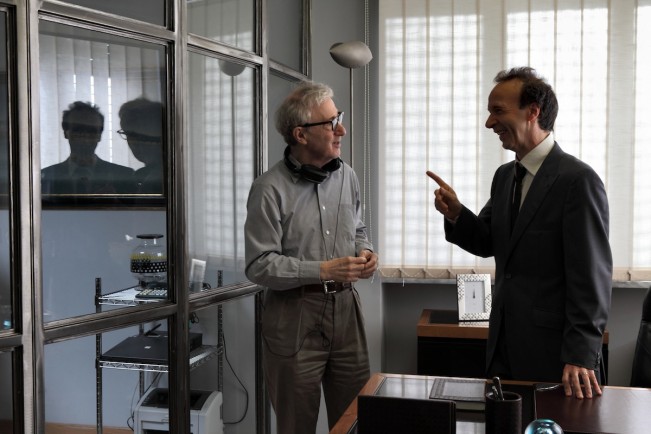

By Ray Pride Pride@moviecitynews.com
Pride’s Friday 5 (June 22, 2012)
1. Brave
 Celebrate PRESTO, the newest software in the Pixar’s proprietary quiver: Brave’s greatest affect comes from its mother-daughter story with mischievous boy triplets underfoot but its greatest effect is Princess Merida’s miracle tresses. As a little girl, Merida has waist-length rag-doll ringlets of red, and when she finally grows to full teen stature of willow-sway, she transforms into a marvel of contemporary animation mathematics, a full flower of alluring flame swirling from countless ones and zeroes, wide eyes centering a mad, dousing, dazzling bower of shoulder-length bounding red curls, like yarn and flame and boundless energy. This algorithm of follicle physics enables a quintessence of red-headedness that never once fails in its jounce and unjaded esprit. [More here.]
Celebrate PRESTO, the newest software in the Pixar’s proprietary quiver: Brave’s greatest affect comes from its mother-daughter story with mischievous boy triplets underfoot but its greatest effect is Princess Merida’s miracle tresses. As a little girl, Merida has waist-length rag-doll ringlets of red, and when she finally grows to full teen stature of willow-sway, she transforms into a marvel of contemporary animation mathematics, a full flower of alluring flame swirling from countless ones and zeroes, wide eyes centering a mad, dousing, dazzling bower of shoulder-length bounding red curls, like yarn and flame and boundless energy. This algorithm of follicle physics enables a quintessence of red-headedness that never once fails in its jounce and unjaded esprit. [More here.]
Plus: an exhaustive primer on the techniques used to animate Merida’s hair.
2. Gerhard Richter Painting
“You can only express in words what words are capable of expressing, what language can communicate. Painting has nothing to do with that.” In the restrained, considered Gerhard Richter Painting, shot in 2009, which observes Richter at work on a set of large-scale abstract canvases, the 79-year-old painter seems avuncular but definitive in his few pronouncements. “A film about a painter must focus on painting,” director Corinna Belz says in her filmmaker’s statement. “It was the actual work in the artist’s studio that interested me most: the authentic and immediate process of putting paint to canvas, and the instruments, gestures, and movements involved, emotionally as well as physically.
 Under the main credits, we hear whistles from the street, birdsong, sounds of the painting studio, thumps and rrrishing of thick paper or canvas. Interspersing little-seen archive footage and preparations for several gallery and museum shows, Belz offers persona, personality, something that grows. Wouldn’t you know: Gerhard Richter painting. Asked about why he’s just made a final series of strokes on a canvas, he smiles his charming smile: “They do what they want.” It’s implication, not pronouncement, not laughing heads, not calculated sentiment. It’s Belz’s selection through editing of moments discovered through her access, often-plain frontal shots of the canvases in progress hung on white walls, with or without Richter intervening, overlayering, squeegeeing. There are three scales, against his paintings, as they occur and emerge and evolve; in the galleries, smiling at the imprecations of the press, the curatorial admirers (who are heard to gust near-nonsensical waves of praise), and maquettes at 1:50 scale of the galleries where the images will reside. It’s geometrical, but canny: the camera moves from close to far, evaluating visually and texturally but not through text or spoken word or Olympian pronouncements.
Under the main credits, we hear whistles from the street, birdsong, sounds of the painting studio, thumps and rrrishing of thick paper or canvas. Interspersing little-seen archive footage and preparations for several gallery and museum shows, Belz offers persona, personality, something that grows. Wouldn’t you know: Gerhard Richter painting. Asked about why he’s just made a final series of strokes on a canvas, he smiles his charming smile: “They do what they want.” It’s implication, not pronouncement, not laughing heads, not calculated sentiment. It’s Belz’s selection through editing of moments discovered through her access, often-plain frontal shots of the canvases in progress hung on white walls, with or without Richter intervening, overlayering, squeegeeing. There are three scales, against his paintings, as they occur and emerge and evolve; in the galleries, smiling at the imprecations of the press, the curatorial admirers (who are heard to gust near-nonsensical waves of praise), and maquettes at 1:50 scale of the galleries where the images will reside. It’s geometrical, but canny: the camera moves from close to far, evaluating visually and texturally but not through text or spoken word or Olympian pronouncements.
Gerhard Richter Painting is now playing at Laemmle Royal in L.A. and Laemmle Playhouse in Pasadena. Upcoming bookings are here.
3. Nate & Margaret
 Nate and Margaret are unlikely bosom buddies in the first feature by Chicago filmmaker Nathan Adloff, a buddy movie that pairs a 19-year-old gay film student (Tyler Ross) and a woman in her fifties, a Rogers Park café waitress, who has hopes of becoming a stand-up comedian with material inspired by her parents’ abusive relationship as well as her own indifferent fortune. Natalie West shuffles amiably; Margaret’s confidence grows as a performer the more open she is about the damage. As does Nate’s, as he meets someone his own age who happens to like him, and to be of the same sex as well. Ah! A first boyfriend. It’s a gentle geek fable with a light, platonic Harold and Maude vibe; dramatic complications involve any number of cruel words spoken in anger. Gaby Hoffman plays a fellow film student who’s full of herself, bragging on her “sick, nasty” parties and asking clumsy, inappropriate questions as if she were the brightest princess of them all. Adloff attended Southern Illinois University at the same time as Joe Swanberg, and was in the cast of Swanberg’s web series “Young American Bodies,” an experience Adloff has cited as an inspiration. [More here.]
Nate and Margaret are unlikely bosom buddies in the first feature by Chicago filmmaker Nathan Adloff, a buddy movie that pairs a 19-year-old gay film student (Tyler Ross) and a woman in her fifties, a Rogers Park café waitress, who has hopes of becoming a stand-up comedian with material inspired by her parents’ abusive relationship as well as her own indifferent fortune. Natalie West shuffles amiably; Margaret’s confidence grows as a performer the more open she is about the damage. As does Nate’s, as he meets someone his own age who happens to like him, and to be of the same sex as well. Ah! A first boyfriend. It’s a gentle geek fable with a light, platonic Harold and Maude vibe; dramatic complications involve any number of cruel words spoken in anger. Gaby Hoffman plays a fellow film student who’s full of herself, bragging on her “sick, nasty” parties and asking clumsy, inappropriate questions as if she were the brightest princess of them all. Adloff attended Southern Illinois University at the same time as Joe Swanberg, and was in the cast of Swanberg’s web series “Young American Bodies,” an experience Adloff has cited as an inspiration. [More here.]
Nate & Margaret opens Friday at the reRun Theater in Brooklyn.
4. Declaration of War
 The bold, hyper Declaration of War is a very personal project for director Valérie Donzelli and co-writer Jérémie Elkaïm—who also star—as a couple who find out their newborn boy is very ill. Their response is as much comic as tragic: how do we battle for the very life of our child in every possible way? In their autobiographical drama, Donzelli and Elkaïm go so far as to name their characters “Romeo” and “Juliette,” their son “Adam,” but insist that their fates are not fully written. How does this beautiful couple challenge ugly possibilities? Among the things that make the nouvelle vague-inflected “Declaration” both eccentric and moving is an oddly optimistic selection of songs and a visual style, shot with a Canon stills camera, that is always darting and fleet. And the ending, combining music and a family by the sea, is a tumble into what will be: what will become of a family of three, tried, tested and true through a war against terrible things outside and inside themselves.
The bold, hyper Declaration of War is a very personal project for director Valérie Donzelli and co-writer Jérémie Elkaïm—who also star—as a couple who find out their newborn boy is very ill. Their response is as much comic as tragic: how do we battle for the very life of our child in every possible way? In their autobiographical drama, Donzelli and Elkaïm go so far as to name their characters “Romeo” and “Juliette,” their son “Adam,” but insist that their fates are not fully written. How does this beautiful couple challenge ugly possibilities? Among the things that make the nouvelle vague-inflected “Declaration” both eccentric and moving is an oddly optimistic selection of songs and a visual style, shot with a Canon stills camera, that is always darting and fleet. And the ending, combining music and a family by the sea, is a tumble into what will be: what will become of a family of three, tried, tested and true through a war against terrible things outside and inside themselves.
Declaration of War is on Amazon and Netflix instant services.
5. To Rome With Love
Woody Allen has said he doesn’t care for the title “To Rome With Love,” which supplanted “Decameron Bop” and “Nero Fiddled,” but my biggest curiosity about creative choices is at what moment Allen and editor Alisa Lepselter threw temporal unity to the wind and intercut the film’s four discrete episodes. After a first assembly when the film’s pacing seemed otherwise interminable? Another oddity is Allen casting against type and turning Diane-Keaton-of-the-moment Greta Gerwig into a retiring whine and allowing the affections of her boyfriend, a wealthy architectural aspirant (Jesse Eisenberg), to be strayed by the arrival of the tiny might of Ellen Page. Still, that sequence provides one lingering medium shot of Alec Baldwin that is almost as much a marvel of Darius Khondji’s craft as several of Page’s face, such as a couple when she’s ostensibly drunk in the late afternoon in a cool cavern of an apartment, her head tilted, the light on her round features golden and the curve of her cheeks glimmering moistly. It’s a feat removed from the actual comedy-drama at hand. [The mediocre still gives no indication of Khondji’s lighting of the scene or of Baldwin’s charming gruff bluster.]
To Rome With Love opens Friday at the Landmark 12 in Los Angeles and the Angelica, City Cinemas and Lincoln Center in Manhattan.















